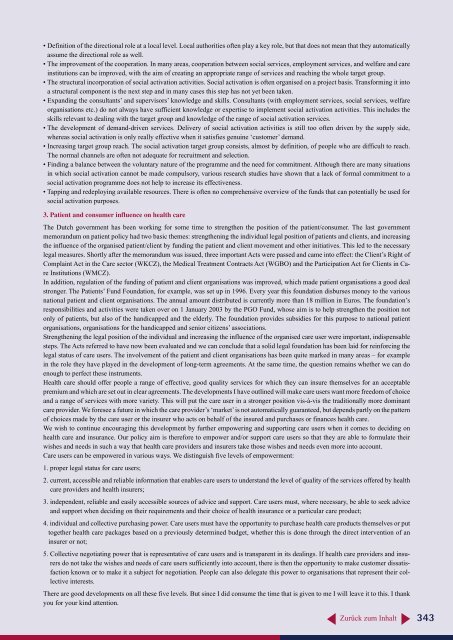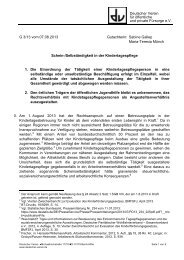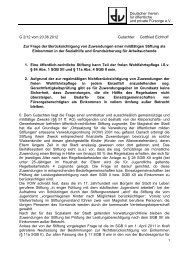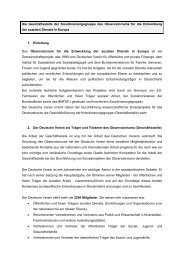Workshop 1.6 - Deutscher Verein für öffentliche und private Fürsorge
Workshop 1.6 - Deutscher Verein für öffentliche und private Fürsorge
Workshop 1.6 - Deutscher Verein für öffentliche und private Fürsorge
Erfolgreiche ePaper selbst erstellen
Machen Sie aus Ihren PDF Publikationen ein blätterbares Flipbook mit unserer einzigartigen Google optimierten e-Paper Software.
• Definition of the directional role at a local level. Local authorities often play a key role, but that does not mean that they automatically<br />
assume the directional role as well.<br />
• The improvement of the cooperation. In many areas, cooperation between social services, employment services, and welfare and care<br />
institutions can be improved, with the aim of creating an appropriate range of services and reaching the whole target group.<br />
• The structural incorporation of social activation activities. Social activation is often organised on a project basis. Transforming it into<br />
a structural component is the next step and in many cases this step has not yet been taken.<br />
• Expanding the consultants’ and supervisors’ knowledge and skills. Consultants (with employment services, social services, welfare<br />
organisations etc.) do not always have sufficient knowledge or expertise to implement social activation activities. This includes the<br />
skills relevant to dealing with the target group and knowledge of the range of social activation services.<br />
• The development of demand-driven services. Delivery of social activation activities is still too often driven by the supply side,<br />
whereas social activation is only really effective when it satisfies genuine ‘customer’ demand.<br />
• Increasing target group reach. The social activation target group consists, almost by definition, of people who are difficult to reach.<br />
The normal channels are often not adequate for recruitment and selection.<br />
• Finding a balance between the voluntary nature of the programme and the need for commitment. Although there are many situations<br />
in which social activation cannot be made compulsory, various research studies have shown that a lack of formal commitment to a<br />
social activation programme does not help to increase its effectiveness.<br />
• Tapping and redeploying available resources. There is often no comprehensive overview of the f<strong>und</strong>s that can potentially be used for<br />
social activation purposes.<br />
3. Patient and consumer influence on health care<br />
The Dutch government has been working for some time to strengthen the position of the patient/consumer. The last government<br />
memorandum on patient policy had two basic themes: strengthening the individual legal position of patients and clients, and increasing<br />
the influence of the organised patient/client by f<strong>und</strong>ing the patient and client movement and other initiatives. This led to the necessary<br />
legal measures. Shortly after the memorandum was issued, three important Acts were passed and came into effect: the Client’s Right of<br />
Complaint Act in the Care sector (WKCZ), the Medical Treatment Contracts Act (WGBO) and the Participation Act for Clients in Care<br />
Institutions (WMCZ).<br />
In addition, regulation of the f<strong>und</strong>ing of patient and client organisations was improved, which made patient organisations a good deal<br />
stronger. The Patients’ F<strong>und</strong> Fo<strong>und</strong>ation, for example, was set up in 1996. Every year this fo<strong>und</strong>ation disburses money to the various<br />
national patient and client organisations. The annual amount distributed is currently more than 18 million in Euros. The fo<strong>und</strong>ation’s<br />
responsibilities and activities were taken over on 1 January 2003 by the PGO F<strong>und</strong>, whose aim is to help strengthen the position not<br />
only of patients, but also of the handicapped and the elderly. The fo<strong>und</strong>ation provides subsidies for this purpose to national patient<br />
organisations, organisations for the handicapped and senior citizens’ associations.<br />
Strengthening the legal position of the individual and increasing the influence of the organised care user were important, indispensable<br />
steps. The Acts referred to have now been evaluated and we can conclude that a solid legal fo<strong>und</strong>ation has been laid for reinforcing the<br />
legal status of care users. The involvement of the patient and client organisations has been quite marked in many areas – for example<br />
in the role they have played in the development of long-term agreements. At the same time, the question remains whether we can do<br />
enough to perfect these instruments.<br />
Health care should offer people a range of effective, good quality services for which they can insure themselves for an acceptable<br />
premium and which are set out in clear agreements. The developments I have outlined will make care users want more freedom of choice<br />
and a range of services with more variety. This will put the care user in a stronger position vis-à-vis the traditionally more dominant<br />
care provider. We foresee a future in which the care provider’s ‘market’is not automatically guaranteed, but depends partly on the pattern<br />
of choices made by the care user or the insurer who acts on behalf of the insured and purchases or finances health care.<br />
We wish to continue encouraging this development by further empowering and supporting care users when it comes to deciding on<br />
health care and insurance. Our policy aim is therefore to empower and/or support care users so that they are able to formulate their<br />
wishes and needs in such a way that health care providers and insurers take those wishes and needs even more into account.<br />
Care users can be empowered in various ways. We distinguish five levels of empowerment:<br />
1. proper legal status for care users;<br />
2. current, accessible and reliable information that enables care users to <strong>und</strong>erstand the level of quality of the services offered by health<br />
care providers and health insurers;<br />
3. independent, reliable and easily accessible sources of advice and support. Care users must, where necessary, be able to seek advice<br />
and support when deciding on their requirements and their choice of health insurance or a particular care product;<br />
4. individual and collective purchasing power. Care users must have the opportunity to purchase health care products themselves or put<br />
together health care packages based on a previously determined budget, whether this is done through the direct intervention of an<br />
insurer or not;<br />
5. Collective negotiating power that is representative of care users and is transparent in its dealings. If health care providers and insurers<br />
do not take the wishes and needs of care users sufficiently into account, there is then the opportunity to make customer dissatisfaction<br />
known or to make it a subject for negotiation. People can also delegate this power to organisations that represent their collective<br />
interests.<br />
There are good developments on all these five levels. But since I did consume the time that is given to me I will leave it to this. I thank<br />
you for your kind attention.<br />
Zurück zum Inhalt<br />
343

















